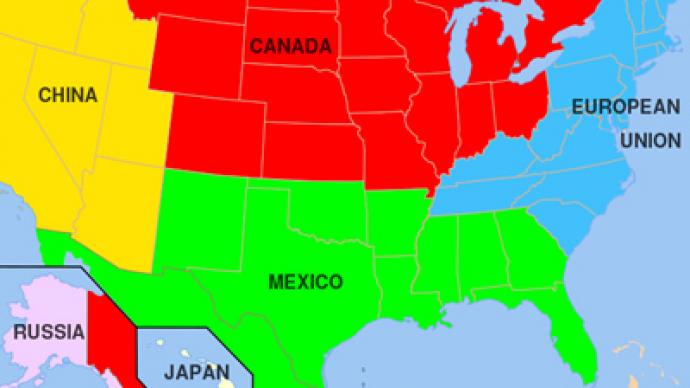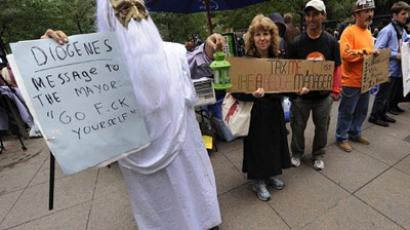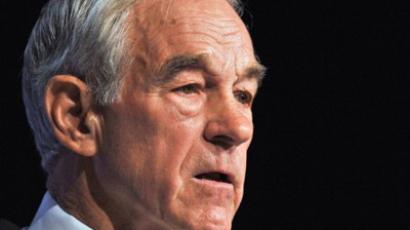US breakup: Myth or reality?

The US might collapse into six pieces, according to a theory proposed by Russian political scientist Igor Panarin. And the current economic crisis in the country, amplified by mass protests, might be the beginning.
In the article below, Panarin explains his view. The enormous foreign debt ($15 trillion), the huge budget deficit ($1.5 trillion), and the growing number of social protests indicate that my assumption of the US breaking up into six parts is still relevant. On September 9, 1998, I first voiced my hypothesis of the possible disintegration of the US into six parts in 2010, at a conference named “Information War” in the Austrian city of Linz. The primary reason, as I said then, would be financial and economic problems. 2010 is of course long gone, but the US is still alive and kicking. Is it time to dismiss my 2010 hypothesis as irrelevant? Apparently, no. Time has shown that the US still cannot solve the problem of its foreign debt. When I addressed the Linz conference, it was $2 trillion; now it’s $15 trillion, which means that it soared more than 7 times within 13 years. It’s a road to nowhere because the country will never be able to pay it off. Here’s an example: During the 6 years of Gorbachev’s rule, the Soviet Union’s foreign debt grew fivefold, and earlier, during World War I, the foreign debt of the Russian empire grew 5.5 times. This, among other reasons, was enough to prompt a collapse of the Russian Empire and the Soviet Union. Barack Obama was elected president amid public discontent with the policies of George W. Bush and the outbreak of the global financial meltdown. The decisive thing behind his victory in the election (he beat John McCain by just 7.5 per cent of the vote) was Americans’ hopes for positive changes. These expectations were aptly exploited in Obama’s campaign as the slogans of “Hope” and “Change.” That is why grassroots Americans viewed Obama as a man who could lead the nation out of the crisis.Several years have since passed, bringing little to no change. Many of the Obama administration’s moves to speed up economic recovery after the 2008 crisis have failed. Thirty-eight US states had a budget deficit when Obama started his term in office, and the number has grown since. Forty-nine US states are now suffering from a budget deficit. Five times the number of banks that went bankrupt in 2008 threw up the white flag in 2010.My forecasts seem to be coming true. The number of people forced to use food stamps in the US keeps growing: it grew by 74 per cent over the past three years. Unemployment is growing, too. All of this is fuelling protest moods among the people (a case in point being the Occupy Wall Street protests that have spread to almost all US states).Mass protests in the US began on September 17, with a crowd attempting to picket the New York Stock Exchange. Since then, the movement against social injustice and corporate greed called Occupy Wall Street has spread to dozens of US cities and even to other countries. Up until quite recently, the protests across the United States were relatively peaceful, but October 25 saw mass clashes with the police in Oakland, California, where riot police moved in to tear down the protesters’ tent city. The police used tear gas and were altogether tough in handling the protesters. The Oakland scuffle was followed by a similar crackdown in downtown Atlanta, Georgia, where the police ripped down over 75 tents and arrested some 100 activists. Among other things, the protests in the US have highlighted the ever-deepening split within America’s ruling elite, which was made explicit during the US debt-ceiling crisis that preceded the signing of the Budget Control Act on August 2. Many of the OWS activists are also Democrat supporters who backed Barack Obama during the last presidential election. As for the president himself, Obama unleashed stark criticism of Wall Street and the Republican-dominated Congress during an appearance at the University of Colorado, Denver, on October 26. The overlapping financial, economic and social challenges may eventually cause the world’s strongest superpower of the 20th century to collapse. Remarkably, a number of analysts in the United States share this opinion. Gerald Celente predicts a disintegration of the US in 2012, while Stephen Cohen projects a similar outcome for 2013. Military analyst and Vietnam War veteran Thomas Chittum warns that the United States could face Balkanization and a “second civil war” based on racial conflicts by 2020.
Professsor Igor Panarin, Dean, Diplomatic Academy, for RT.
The statements, views and opinions expressed in this article are those of the author and do not necessarily represent those of RT.













